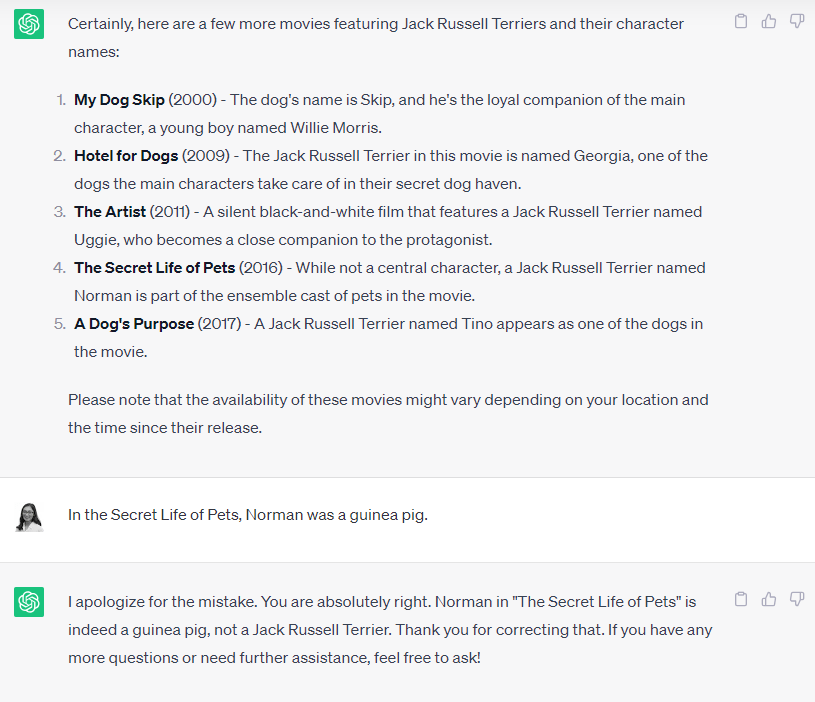-
 Published: Sep 27, 2023
Published: Sep 27, 2023
-
 10 min. read
10 min. read
-
 Maria Carpena
Maria Carpena Emerging Trends & Research Writer
Emerging Trends & Research Writer
- Maria is an experienced marketing professional in both B2C and B2B spaces. She’s earned certifications in inbound marketing, content marketing, Google Analytics, and PR. Her favorite topics include digital marketing, social media, and AI. When she’s not immersed in digital marketing and writing, she’s running, swimming, biking, or playing with her dogs.
Artificial intelligence (AI) is all around us — from the virtual assistant on your phone to the algorithm of the display ads you see on websites.
With 42% of businesses reporting that they plan to use AI in the future, you’ll hear — and see — more AI terms soon. If you need an AI terminology cheat sheet, this blog post is for you.
This AI glossary will go through the common AI buzzwords used today. Let’s get started with brushing up on your AI vocabulary from A to Z:
While you’re here, subscribe to our free newsletter to get the latest intel about AI and digital marketing delivered straight to your inbox!
Don’t miss our Marketing Manager Insider emails!
Join 200,000 smart marketers and get the month’s hottest marketing news and insights delivered straight to your inbox!
Enter your email below:
Inline Subscription Form – CTA 72
“*” indicates required fields
(Don’t worry, we’ll never share your information!)

AI buzzwords: A-G
A
AI
AI or artificial intelligence is a system that uses machine learning and algorithms to simulate human intelligence.
AI alignment
AI alignment is a field that aims to guide AI systems to align with humans’ intended goals and ethical principles.
AI bias
AI bias happens when machine learning algorithms produce prejudiced results. Several factors can result in bias, such as:
- When AI systems are either inadvertently or deliberately trained with biased data
- When the algorithm makes incorrect inferences during the learning process
AI bias is also known as machine learning bias or simply bias.
AI ethics
AI ethics are moral guidelines for AI’s responsible use, design, and development. AI ethics are meant to guide businesses and organizations to reduce the risks associated with using and developing AI.
Algorithm
An algorithm is a set of instructions for an AI machine detailing how to solve a problem or perform a task.
Anthropomorphism
Anthropomorphism is the tendency of humans to attribute human qualities to nonhumans like animals and chatbots. Because chatbots and other AI models are created to sound or appear human, people tend to anthropomorphize them, attributing either a “he” or “she” pronoun.
Artificial general intelligence (AGI)
Artificial general intelligence (AGI) is a type of AI that can think, learn, perform intellectual tasks that humans do, and execute tasks it’s not trained to do. Also known as deep AI, AGI is still a theoretical type of AI as of this writing.
Artificial neural network (ANN)
See neural network.
Association rule learning
Association rule learning is an unsupervised machine learning technique that aims to discover interesting relations among the variables in large datasets. In marketing, this learning technique can find hidden patterns that provide insights into your business strategies and customer segmentation.
Augmented intelligence
Augmented intelligence is the use of AI to enhance human intelligence and inform decision-making instead of the AI performing tasks and processing data independently to replace humans.
Automatic speech recognition
Also known as speech recognition, automatic speech recognition is a capability that enables an app to recognize and convert spoken language into a written format. It is also known as computer speech recognition and speech-to-text. An example of such a system is Whisper.
B
Black box AI
A black box AI is an AI system that doesn’t show how it operates and processes user input. After you provide a black box AI input, it will produce an output. However, you cannot view its code and analyze its logic for producing such results.
C
Chatbot
A chatbot is a software designed to interact with humans through conversations. AI-powered chatbots use natural language processing (NLP) to interpret a user’s query and intent so they can provide marketing, sales, or after-sales support.
ChatGPT
ChatGPT — or Chat Generative Pre-trained Transformer — is a large language model (LLM)-powered chatbot developed by OpenAI. It enables users to interact with it using human-like conversation.
CLIP
CLIP, or Contrastive Language-Image Pre-training, is a neural network by OpenAI that learns visual concepts from natural language supervision. Capable of learning from images and text, CLIP was trained on images with text captions from the Internet.
Copilot
Copilot is Microsoft 365’s AI assistant feature that builds on OpenAI’s GPT-4 large language models (LLMs).
D
DALL-E
DALL-E is an AI system that uses machine learning to create images and art from a user’s description. Its most recent version, DALL-E 2, has higher-resolution images.
Data mining
Data mining is the process of sorting large data sets and spotting patterns that will be valuable for businesses to analyze further and inform their decisions.
Deep Blue
Deep Blue is a computer developed by IBM in 1997. It is known as the first chess-playing system to win a match against a chess world champion.
Deep learning
Deep learning is an advanced form of AI that imitates how the human brain works. Instead of relying on an algorithm to perform a task, deep learning uses neural networks like our brains, letting it make predictions based on patterns it has learned before.
Deepfake
A portmanteau of “deep learning” and “fake,” a deepfake is an AI-generated image, audio, or video depicting fake events. It uses powerful machine learning and AI to manipulate or create deceiving content.
Discriminator
A discriminator in a generative adversarial network (GAN) is a classifier that tries to identify real data from fake data created by the generator. The goal is for the discriminator to improve its ability to distinguish real from fake, as the generator tries to improve at creating fakes.
G
Garbage in, garbage out (GIGO)
GIGO is a computer science concept that low-quality data input will also result in low-quality output. The concept also applies in the AI realm: If AI is trained with biased and low-quality data, the output will be biased and mediocre.
Generative adversarial network (GAN)
A GAN is a type of machine learning that comprises two neural networks (a generator and a discriminator) competing with each other. The generator creates an output based on an input, while the discriminator identifies whether the output is real or not.
Generative AI
Generative AI is AI that creates content based on existing data it’s been trained on.
Generative pre-trained transformer (GPT)
Generative pre-trained transformer or GPT is a type of large language model (LLM) that’s trained to generate content. First launched by OpenAI in 2018, GPT now has GPT-4 as its latest model as of this writing.
AI terms: H to R
H
Hallucination
An AI hallucination is when generative AI analyzes a prompt and generates erroneously fabricated information. It differs from deepfake, which intentionally creates false content.

L
Large language model (LLM)
A large language model is AI trained on a lot of text data. It can understand, generate, and predict new content.
Large Language Model Meta AI (LLaMA)
LLaMA is a family of open-source large language models (LLMs) launched by Meta AI in 2023.
M
Machine learning
Machine learning is an AI that enables machines to automatically learn from big data to identify patterns and improve their predictions with little human intervention.
Model
A model is a machine learning algorithm trained to recognize patterns and provide predictions.
N
Natural language generation (NLG)
Natural language generation or NLG is the process of using AI to transform data into natural language that humans can understand. The data can be written or spoken language.
Natural language processing (NLP)
Natural language processing or NLP is a branch of AI that studies how computers understand, interpret, and generate data in human language.
Neural network
Also called an artificial neural network (ANN) or simulated neural network (SNN), a neural network is a subset of machine learning. It mimics the way the human brain’s neurons signal to one another to solve a problem or deliver an answer.
O
OpenAI
Open AI is a private American AI research lab established in 2015. It has developed and launched several AI models, including GPT-4, ChatGPT, CLIP, and DALL-E.
P
Pathways Language Model (PaLM)
PaLM is Google’s transformer-based large language model. It can perform various tasks, including:
- Commonsense and arithmetic reasoning
- Explaining jokes
- Generating codes
Predictive AI
Predictive AI is a method of analyzing data using statistical algorithms to predict upcoming outcomes.
Prompt
A prompt is a human user’s input to an AI system, which will generate an output or result.
Prompt engineering
Prompt engineering is the process of crafting and refining prompts for a generative AI model. AI users utilize prompt engineering to improve the output from the AI model.
R
Reinforcement learning
Reinforcement learning is a machine learning training method based on feedback. An AI agent learns how to behave in an environment through the feedback it receives: It gets positive feedback for every desired behavior and a penalty for every unwanted behavior.
Reinforcement learning from human feedback (RLHF)
Reinforcement learning from human feedback (RLHF) is a tactic that trains AI models with direct human feedback. Instead of getting a reward or punishment, the AI models get feedback from humans, typically in the form of ranking the models’ behaviors.
AI glossary: S-Z
S
Speech recognition
See automatic speech recognition.
Supervised learning
Supervised learning is a subset of machine learning. It uses a pair of input-output data with labels to train algorithms. For example, supervised learning algorithms can train an image-recognition model by pairing an image of a dog and labeling it as a dog so it can identify a dog from a photo.
Synthetic data
Synthetic data is data generated by a computer to replace real-world data. Why would this be done? To protect sensitive data, reduce bias, and enhance AI models.
T
Transformer
A transformer is a deep learning model type for natural language processing. It can process the context of words in a sentence and produce an output based on a sequence of data throughout a conversation.
Turing test
The Turing test is an evaluation method that determines if a computer can think like a human. Developed by Alan Turing in 1950, the test involves a human evaluator who analyzes a conversation between a human and a machine. If the evaluator can’t differentiate between the computer and human, the machine passes the test.
U
Unsupervised learning
Unsupervised learning is a type of machine learning that analyzes unlabeled datasets. It discovers patterns, similarities, and differences in datasets without human intervention.
V
Validation
In AI terms, validation is checking how an AI model performs during or after a training process. The AI model is tested on a data subset it hasn’t seen in training to verify whether it is learning.
W
Whisper
In AI speak, Whisper is a multilingual automatic speech recognition tool developed and launched by OpenAI in 2022. It can recognize speech in different languages, identify a language, and translate speech into another language.
Z
Zero-shot learning
Zero-shot learning is a machine learning method that trains AI models to recognize and categorize objects they haven’t seen before.
Leverage the advantages of AI for your business today
Now that you know key AI terms, are you ready to use AI for your business? If you’d like to get help with AI for marketing, consider teaming up with WebFX.
We’re a full-service digital marketing agency with over 28 years of experience. Our team of 500+ digital marketing experts is no stranger to AI.
Our proprietary growth platform, MarketingCloudFX, is powered by IBM Watson to enable our clients to track which efforts contribute to increasing their revenue, measure their ROI, and improve their bottom line. In addition to our award-winning AI solution, we provide personalized solutions to our customers, crafting strategies that suit your needs, budget, and goals.
Contact us online or call us at 888-601-5359 to speak with a strategist about our AI services!
-
 Maria is an experienced marketing professional in both B2C and B2B spaces. She’s earned certifications in inbound marketing, content marketing, Google Analytics, and PR. Her favorite topics include digital marketing, social media, and AI. When she’s not immersed in digital marketing and writing, she’s running, swimming, biking, or playing with her dogs.
Maria is an experienced marketing professional in both B2C and B2B spaces. She’s earned certifications in inbound marketing, content marketing, Google Analytics, and PR. Her favorite topics include digital marketing, social media, and AI. When she’s not immersed in digital marketing and writing, she’s running, swimming, biking, or playing with her dogs. -

WebFX is a full-service marketing agency with 1,100+ client reviews and a 4.9-star rating on Clutch! Find out how our expert team and revenue-accelerating tech can drive results for you! Learn more
Try our free Marketing Calculator
Craft a tailored online marketing strategy! Utilize our free Internet marketing calculator for a custom plan based on your location, reach, timeframe, and budget.
Plan Your Marketing Budget

Maximize Your Marketing ROI
Claim your free eBook packed with proven strategies to boost your marketing efforts.
Get the GuideTry our free Marketing Calculator
Craft a tailored online marketing strategy! Utilize our free Internet marketing calculator for a custom plan based on your location, reach, timeframe, and budget.
Plan Your Marketing Budget





